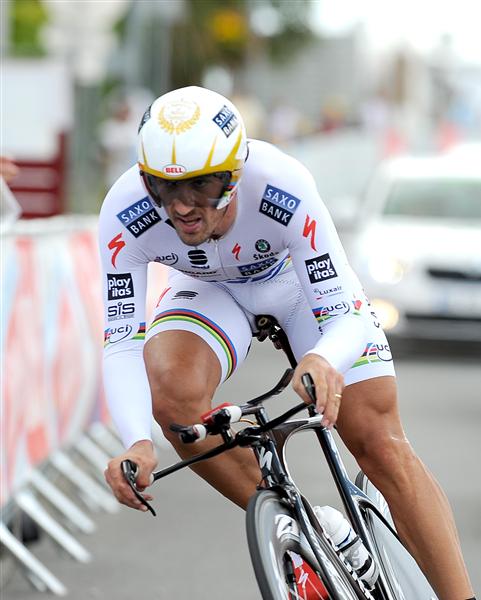Here are some things to ponder when writing about outlandish claims regarding the secret of Fabian Cancellara’s success.
“2.5 seconds faster over a kilometer” is only meaningful if you tell us what sort of speed you’re talking about. A 2.5 second improvement over a 5 KM/H kilo isn’t terribly impressive – that’s 12:00 versus 11:57.5, a .35% reduction. A 2.5 second improvement over a 60 KM/H one is – that’s 1 minute versus 57.5, a 4% reduction.
“95% less friction” is only meaningful if you tell us what thats relative to. Compared to a wheel with bushings? Sealed bearing? Loose ball? Ceramic? In a situation where friction is already negligible, does reducing it more really have an impact?
A website that claims advanced engineering but gives you numbers like the above isn’t tell you the whole story.
So before you write about Fabian’s bearings, here’s what you should do:
Step 1: Go to: http://www.analyticcycling.com/ForcesSpeed_Page.html
Step 2: Set slope to 0 (perfectly flat) and power to 500 watts. Set the Coefficient of Rolling Resistance to 0 – lets pretend we live in a world without rolling resistance. Everything else you can just leave the defaults.
The output of the computation will give you 14.83 m/s, which is 67.43s for a kilometer – on the track, the world record is a little less than a minute for a standing start.
Step 3: Now set the power to 550 watts, and recalculate
The resulting speed is 15.31 m/s, which is a 65.3 second kilometer.
A 50 watt increase from 500w gives you less than the claimed 2.5s – so clearly we’re not talking about a competitive track kilometer. Let’s aim a little lower.
Repeat the above for 200w and 220w – also a 10% improvement, with power numbers more in line with rolling along at 24mph over flat ground. OK! The difference in times between 200w and 220w is in excess of 2.5 seconds for a kilometer – 91.49s versus 88.65, a 2.84 second improvement. In fact, you only need to generate an additional 17.5 watts (217.5 versus 200) to see a 2.5 second improvement.
When was the last time you heard about an instant 8.75% overall power output increase for a story that didn’t involve pharmacology? Given that research indicates that over (perhaps well over) 90% of loss at race speed is due to aerodynamics, does it makes sense that you’d see almost everything but aerodynamics wiped out by just replacing some bearings, when some portion of that 10% is actually tire rolling resistance? Does it seem odd that the numbers make a lot more sense the lower your power output? That’s because you don’t have enough information to fact check these claims. Extraordinary claims require – you guessed it – extraordinary evidence, and we’re lacking it.
Step 4: Call someone who can tell you if a 2.5s improvement over a kilometer by replacing nothing but bearings is sane for the power output of someone like Fabian Cancellara. Chances are this person will tell you way more than you want to know, in an extremely technical manner. Ask them for a punchline, and you’ll probably be told “No, its not sane”.
If there’s a story here at all, its that Fabian Cancellara keeps abreast of new technologies, and is willing to give them a try – and bearings would certainly be a more reasonable place to try new ideas than some of the genuinely ridiculous things some other pro’s have tried. Sure, its less exciting an article than bearing-doping, but you’ll be contributing something worthwhile to the noise. And you’ll still have plenty of opportunities to make jokes about Fabian Cancellara’s balls.


Good topic. Can't tell you how many riders I meet out on the road that can't wait to get the new tri-matrix, split atomic helix carbon frame that they read about in Bicycling Magazine, as if that would make them faster in flat terrain. Doesn't help much if you have the latest, greatest technology but can't pedal smoothly. I think Merckx said it best, to get faster, ride lots.
It looks like few mistakes over the first paragraph (or that I really just don't understand….):
5 KM/H kilo /a .333%
Riding at 5 km/h, it'll take you 12 minutes to complete a kilometer. Shave 2.5 seconds off, and you're talking about a 1/3 of 1 percent difference.
(and yep, there was a typo! Those are 12 minute kilo's, not 12.5. Late night!)
Pingback: If You Can’t Beat ‘em…Call ‘em a Cheat? | Portland Elbow Warmers